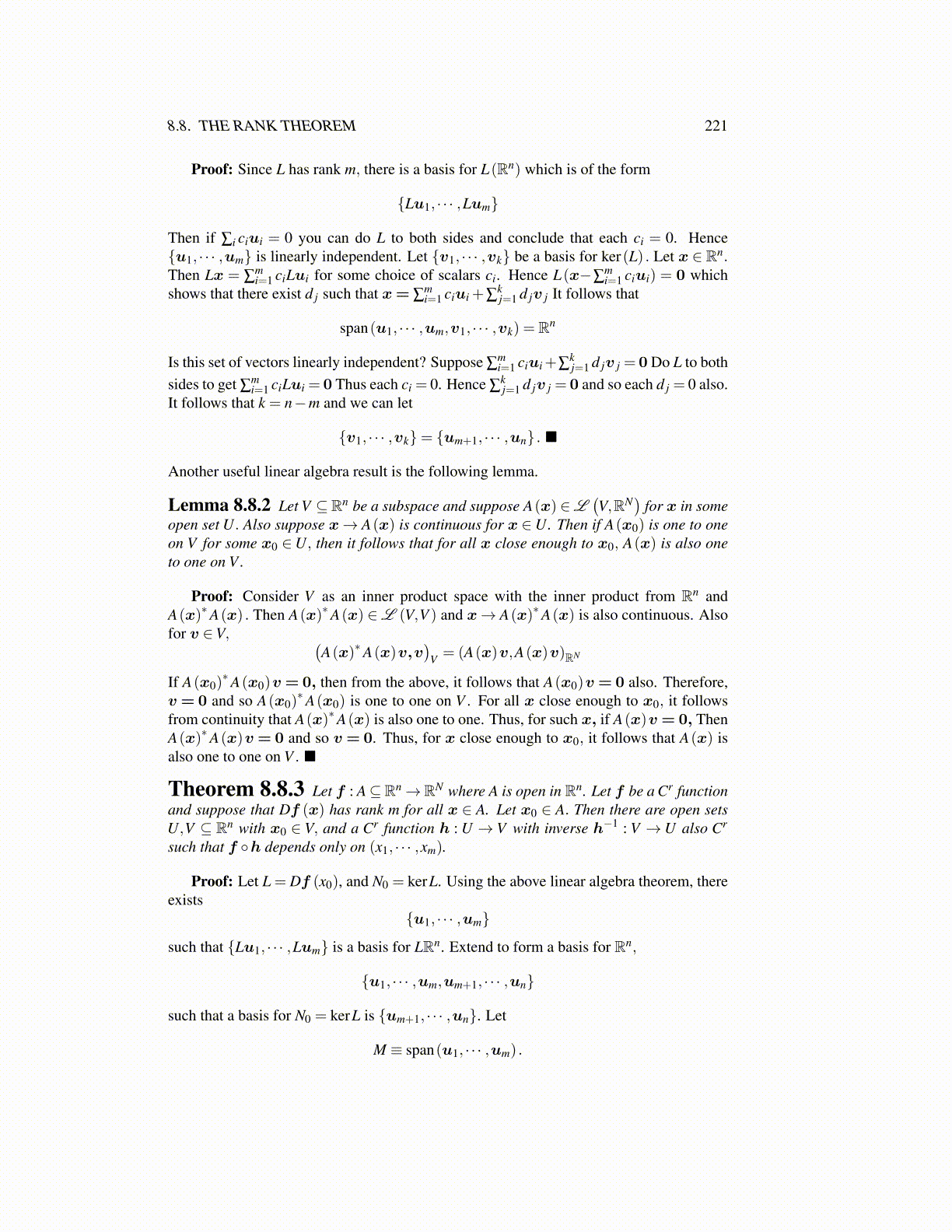
8.8. THE RANK THEOREM 221
Proof: Since L has rank m, there is a basis for L(Rn) which is of the form
{Lu1, · · · ,Lum}
Then if ∑i ciui = 0 you can do L to both sides and conclude that each ci = 0. Hence{u1, · · · ,um} is linearly independent. Let {v1, · · · ,vk} be a basis for ker(L) . Let x ∈ Rn.Then Lx = ∑
mi=1 ciLui for some choice of scalars ci. Hence L(x−∑
mi=1 ciui) = 0 which
shows that there exist d j such that x= ∑mi=1 ciui +∑
kj=1 d jv j It follows that
span(u1, · · · ,um,v1, · · · ,vk) = Rn
Is this set of vectors linearly independent? Suppose ∑mi=1 ciui+∑
kj=1 d jv j = 0 Do L to both
sides to get ∑mi=1 ciLui = 0 Thus each ci = 0. Hence ∑
kj=1 d jv j = 0 and so each d j = 0 also.
It follows that k = n−m and we can let
{v1, · · · ,vk}= {um+1, · · · ,un} . ■
Another useful linear algebra result is the following lemma.
Lemma 8.8.2 Let V ⊆Rn be a subspace and suppose A(x) ∈L(V,RN
)for x in some
open set U. Also suppose x→ A(x) is continuous for x ∈U. Then if A(x0) is one to oneon V for some x0 ∈U, then it follows that for all x close enough to x0, A(x) is also oneto one on V .
Proof: Consider V as an inner product space with the inner product from Rn andA(x)∗A(x) . Then A(x)∗A(x) ∈L (V,V ) and x→ A(x)∗A(x) is also continuous. Alsofor v ∈V, (
A(x)∗A(x)v,v)
V = (A(x)v,A(x)v)RN
If A(x0)∗A(x0)v= 0, then from the above, it follows that A(x0)v= 0 also. Therefore,
v= 0 and so A(x0)∗A(x0) is one to one on V . For all x close enough to x0, it follows
from continuity that A(x)∗A(x) is also one to one. Thus, for such x, if A(x)v= 0, ThenA(x)∗A(x)v= 0 and so v= 0. Thus, for x close enough to x0, it follows that A(x) isalso one to one on V . ■
Theorem 8.8.3 Let f : A⊆Rn→RN where A is open in Rn. Let f be a Cr functionand suppose that Df (x) has rank m for all x ∈ A. Let x0 ∈ A. Then there are open setsU,V ⊆ Rn with x0 ∈ V, and a Cr function h : U → V with inverse h−1 : V →U also Cr
such that f ◦h depends only on (x1, · · · ,xm).
Proof: Let L = Df (x0), and N0 = kerL. Using the above linear algebra theorem, thereexists
{u1, · · · ,um}
such that {Lu1, · · · ,Lum} is a basis for LRn. Extend to form a basis for Rn,
{u1, · · · ,um,um+1, · · · ,un}
such that a basis for N0 = kerL is {um+1, · · · ,un}. Let
M ≡ span(u1, · · · ,um) .